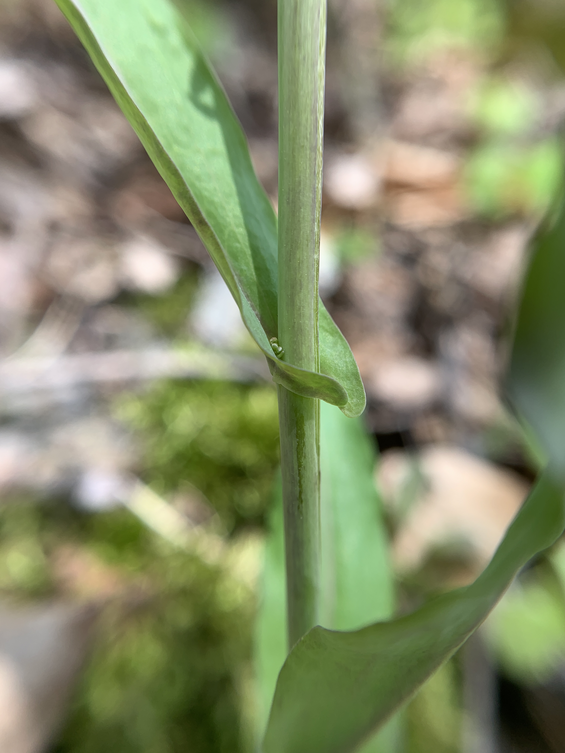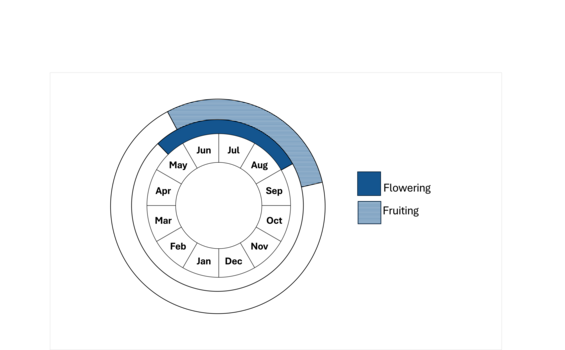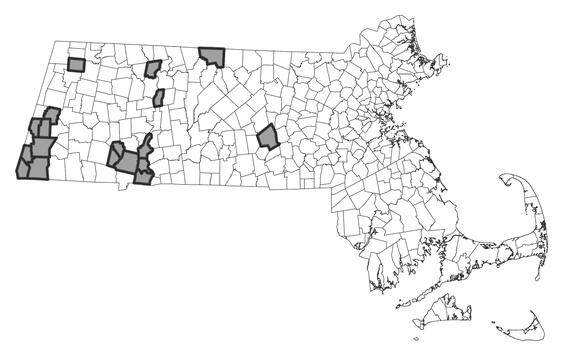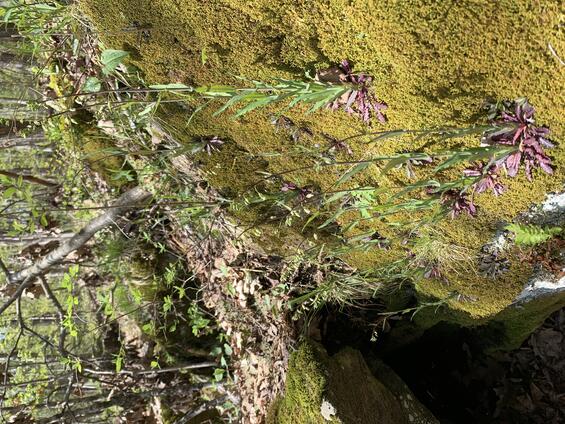- Scientific name: Borodinia laevigata (Muhl. ex Willd.) P.J. Alexander & Windham
- Synonymy: Boechera laevigata (Muhl. ex Willd.) Al-Shehbaz, Arabis laevigata (Muhl. ex Willd.) Poir.
- Species of Greatest Conservation Need (MA State Wildlife Action Plan)
- Special Concern (MA Endangered Species Act)
Description

Close up of clasping leaves, image by Peter Grima.
Smooth rock-cress (Borodinia laevigata) is in the mustard family (Brassicaceae). It is a facultative biennial, persisting for a year or more as basal rosettes of spoon-shaped, sparsely hairy leaves. After reaching a critical size, smooth rock-cress bolts and blooms, producing greenish-white flowers from late May to late August.
It is best to observe smooth rock-cress both in flower and in fruit to confirm identification. It is a glabrous (hairless) plant, 0.3-1 m (1–3 ft) in height, and glaucous (with a white waxy cast) throughout. The stem leaves average 13 in number below the first inflorescence; they are alternate, lance-shaped, and clasping, 5-15 cm (2–6 in) in length. The leaf margins are smooth or serrated. The flowers, borne on a terminal raceme, have four petals, which are equal in length to the sepals, or slightly longer. The siliques (fruits) are slender pods characteristic of mustards. In smooth rock-cress the pods are 5-10 cm (2-4 in) in length, and grow conspicuously outward, arching downward from the stem. Nerves in the silique are absent or faint; if present, they extend only to the middle of the silique. The seeds are arranged in one row and are narrowly winged.
Smooth rock-cress resembles several other mustards that occur in Massachusetts. Hairy rock-cress (Arabis pycnocarpa), Drummond’s rock-cress (Boechera drummondii), and tower mustard (Turritis glabra) all have straight, erect pods that do not arch outwards. Sicklepod (Borodinia canadensis) has pods that are curved, but the stem leaves are not clasping. Green rock-cress (B. missouriensis; Threatened) has more numerous and densely packed stem leaves, and petals that are nearly twice as long as the sepals.
In flower, image by Karro Frost.
In fruit, image by Lynn Harper.
Life cycle and behavior

Seeds from smooth rock-cress will start to break their dormancy after cold stratification during the winter. Germination occurs in March and April; those that don’t germinate in the first year will become part of the seed bank and may germinate in another year in the spring. The first-year plants are small rosettes, and plants may spend another year or two just as a rosette of leaves. When the plant is mature (second or third year), it will send up a flowering stalk and bloom starting in mid-May, with some plants not finishing blooming until the end of August. Seed set starts as soon as pollination has occurred; and small siliques can often be observed extending from senescing flowers. Seeds start dispersing from mature siliques in mid-June and dispersal continues through September. The mature plant flowers and produces seed only once, then dies. Smooth rock-cress are high seed producers, but only a fraction of the seed will survive to become mature plants. Bloom et al. (2002) cited their prior study that determined only 5% of seedlings survived the first year, and only 1% of those seedlings survived to reproduce.
Population status
Smooth rock-cress is listed under the Massachusetts Endangered Species Act as a species of special concern. All listed species are legally protected from killing, collection, possession, or sale, and from activities that would destroy habitat and thus directly or indirectly cause mortality or disrupt critical behaviors. Smooth rock-cress is currently known from 32 populations in Berkshire, Franklin, Hampden, and Worcester counties, and is historically known from eleven additional populations, including at least one in Hampshire County. Only six of the populations recently observed have vigorous healthy populations. At least three populations were so small that they were ranked as not likely to survive.
Distribution and abundance
Smooth rock-cress is known from much of eastern and central North America, from Quebec and Maine south to Georgia, west to Ontario, South Dakota, Iowa, Kansas, and Oklahoma. Throughout much of its range it is considered secure. In New England, it is considered critically imperiled in Maine and New Hampshire, as well as imperiled in Massachusetts.

Distribution in Massachusetts
1999-2024
Based on records in the Natural Heritage Database
Habitat
In Massachusetts, smooth rock-cress inhabits rich, rocky deciduous woods, rich rocky hillsides, ledges, and talus slopes, and floodplain thickets and woodlands. It occupies open to shaded sites on dry to mesic soils. The associated species are numerous and diverse depending on the habitat type, but may include basswood (Tilia Americana), sugar maple (Acer saccharum), white ash (Fraxinus americana), and hop hornbeam (Ostrya virginiana) in the canopy, and witch hazel (Hamamelis virginiana), spicebush (Lindera benzoin), Jack-in-the-pulpit (Arisaema triphyllum), ostrich fern (Matteuccia struthiopteris), and marginal wood-fern (Dryopteris marginalis) in the understory.
Healthy habitats are vital for supporting native wildlife and plants. Explore habitats and learn about conservation and restoration in Massachusetts.

Smooth rock-cress (Borodinia laevigata) in bud and flower, image by Peter Grima.
Threats
The primary threats to smooth rock-cress are invasive species competing and shading out seedlings. Another threat is browse by deer and other animals. Logging and development are also threats on unprotected lands. Some populations are located along woodland trails, and trampling by hikers or off-road vehicles is another potential threat. In addition, these populations may also be threatened by trail or road maintenance. For populations within river floodplain forests, flooding, scour, and bank collapse are potential threats. Finally, small populations are threatened by stochastic events that could extirpate the population.
Conservation
Survey and monitoring
Smooth rock-cress is a biennial, and the number of plants observed each survey can vary widely. To assess the population accurately, surveys are needed regularly. This species can be surveyed from May through September, though it is most helpful to observe both flowering and fruiting material. Each flowering stem and each basal rosette represents a single individual. Additional surveys are needed particularly where only a handful of plants have been found recently.
Management
All active management of rare plant populations (including invasive species removal) is subject to review under the Massachusetts Endangered Species Act and should be planned in close consultation with the MassWildlife’s Natural Heritage & Endangered Species Program. Primary management includes removal of invasive plants in smooth rock-cress habitat and maintaining the habitat partially open.
Research needs
There has been substantial genetic work with this family recently, and this and related species have been moved into new genera, then moved again, from Arabis to Boechera and now to Borodinia. In the process, Borodinia missouriensis was split from B. laevigata; previously it was considered a variety of smooth rock-cress. Research is needed into increasing the survival of seedlings to mature plants for wild-growing plants. Common garden experiments could help determine more favorable growing conditions and produce seeds for restoration or augmentation in areas where the populations are declining.
References
Al-Shehbaz, I. 1988. The genera of Arabideae (Cruciferae; Brassicaceae) in the Southeastern United States. Journal of the Arnold Arboretum. 69: 132.
Bloom, Thomas C., Jerry M. Baskin, and Carol C. Baskin. “Ecological life history of the facultative woodland biennial Arabis laevigata variety laevigata (Brassicaceae): seed dispersal” Journal of the Torrey Botanical Society 129(1), 2002, pp. 21-28.
Gleason, Henry A., and Arthur Cronquist. Manual of Vascular Plants of Northeastern United States and Adjacent Canada, Second Edition. Bronx, NY: The New York Botanical Garden, 1991.
Haines, Arthur. Flora Novae Angliae. New England Wild Flower Society, Yale University Press, New Haven, CT. 2011.
Mulligan, G. 1995. Synopsis of the genus Arabis (Brassicaceae) in Canada, Alaska and Greenland. Rhodora 97: 109
NatureServe. 2025. NatureServe Network Biodiversity Location Data accessed through NatureServe Explorer [web application]. NatureServe, Arlington, Virginia. Available https://explorer.natureserve.org/. Accessed: 2/27/2025.
POWO (2025). "Plants of the World Online. Facilitated by the Royal Botanic Gardens, Kew. Published on the Internet; https://powo.science.kew.org/ Retrieved 26 February 2025."
Contact
| Date published: | March 25, 2025 |
|---|